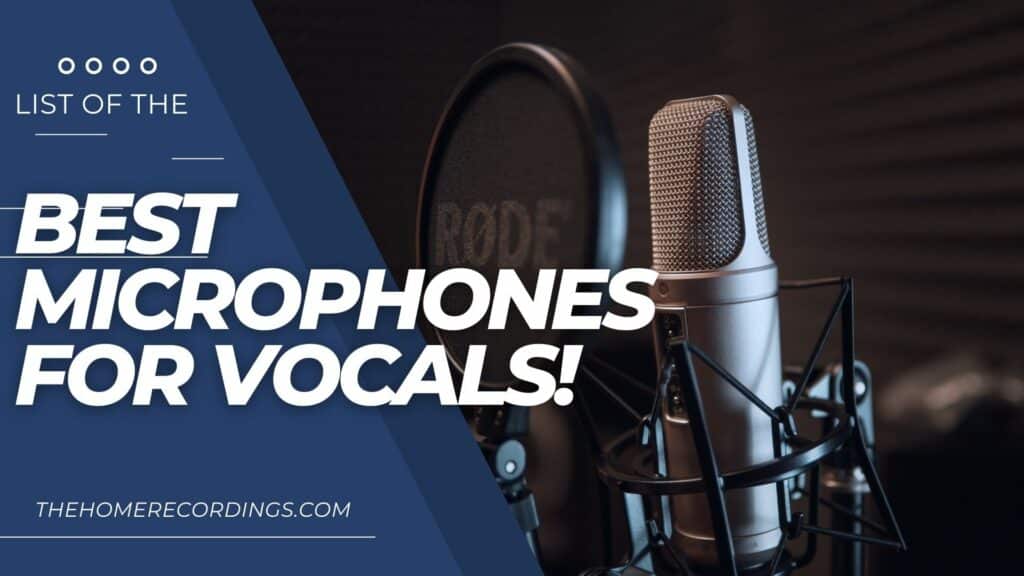Last updated on December 29th, 2023 at 09:42 pm
When I was just starting to learn about audio engineering, one of my first questions was:
‘Which is the absolute best microphone for recording vocals?’
If we take this question literally, then we would need to choose a microphone that costs at least $3000, and still, we would need to figure out which of those is the best one. To be honest, you won’t find those types of microphones in most studios, and even less in small basic home studios.
This is why I think that it makes absolutely no sense to list them in this post since no home studio owner in their right mind would ever spend that kind of money on a single mic.
In this article, I will give you my list of the top microphones for recording vocals, including dynamic, condenser, and USB microphones, which won’t make you go bankrupt.
So, for the purposes of this article, I will keep all the microphones under $700.
Important note: Condenser microphones require phantom power to work properly, so you will at least need an audio interface or a mixer that can provide it.
TLDR: Top 3 Microphones for Vocals
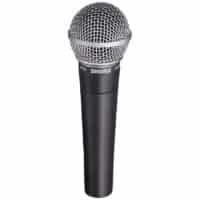
Shure SM58
Cost-efficient dynamic Microphone for vocals and other sources.
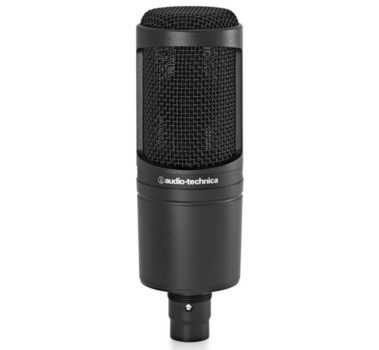
AT2020
The Audio-Technica AT2020 is an excellent vocal mic for $99.

Rode NT-USB Mini
Great-sounding mic with high-quality included software and effects.
Dynamic Vs Condenser for Vocals
Dynamic Microphones have a coil inside them that moves when the air pressure around it changes (when it’s picking up sound), and this generates an electric current that then gets translated into a signal that can be recorded by your Audio Interface/Mixer.
Dynamic Microphones are self-powered, meaning that the coil can generate sufficient electric energy to create a signal that is loud enough for the audio interface to convert into a clean recording.
Condenser Microphones, on the other hand, use a thin conductive membrane to pick up air pressure changes, but the current that this membrane generates isn’t strong enough to provide your recording device with a loud/clean enough signal. This is why Condenser microphones need additional power to be supplied to them, in this case called phantom power, which almost all recording devices are capable of providing.
The main difference in sound between dynamic and condenser microphones is in how they pick up that sound: The coil in dynamic microphones is heavier and harder to move than the membrane on a condenser microphone. So, higher-pitched sounds don’t produce as much energy as lower-pitched ones, resulting in condenser microphones usually being better at picking up subtle higher-pitched sounds.
This is also the reason why dynamic microphones are better at rejecting feedback.
In Short: If you need a versatile microphone (recording & live), then dynamic is your best bet. Also, if you want to plug it straight into your computer, unless you get a dedicated USB mic or an audio interface with phantom power, the only option you have is a dynamic one. Condenser microphones are used 99% of the time for studio recording and not for live performances because of how prone to feedback they are.
What is the best Polar Pattern for Vocal Microphones?
Cardioid or Super-Cardioid.
Cardioid and super-cardioid microphones are designed to only pick up sound from the front and reject as much from the sides and the back as possible. This is very important when recording any sort of vocals because you want to keep external noises out of the recording.
There is one thing to be said about omni-directional or bidirectional microphones, however: If you have a very well-treated room and there isn’t that much risk of the microphone picking up unwanted noises bouncing off the walls, then omni or bidirectional microphones can be used as well since they have the added benefit of not suffering from the “proximity effect” that cardioid microphones do.
The proximity effect happens when the source is too close to the microphone, resulting in an overly boosted low end.
But in 99% of the situations, go with cardioid or super-cardioid.
Sound Quality (Expensive isn’t always “Better”)
While you might think that a microphone can make or break your record and that you need to use the absolute best one there is (and also spend a ton to get great results), this isn’t really the case.
The difference between a $100 mic and a $2000 one is there, but it’s only a very slight difference, generally in how flat they sound: More expensive microphones are designed to record the source “as is”, without adding any EQ to the signal.
However, after years of mixing, I (as well as multiple other producers I talked to) tend to apply a hefty amount of EQ to the vocals, especially in Pop music, to the point where on its own it sounds too “thin” if you listen to it on its own.
Next time you listen to a pop song, carefully pay attention to the vocals: You’ll probably notice that there is no bass to be found anywhere.
Some of the more affordable microphones, already apply a similar EQ curve to the signal, actually making the process easier for you.
In Short: Can you get better results with an expensive microphone? Sure, but it’s not as big of a difference as you might think. In fact, some of the best albums in history have been recorded with $99 dynamic microphones.
Let’s get started with the list!
List of the Best Dynamic Microphones for Vocals!
Note: These will be ordered by versatility & price. For example: Can it be used live & in the studio? Only in the studio? How much does it cost compared to the rest, etc.
Shure SM58
Most Versatile: Live/Studio, Vocals & other Sources
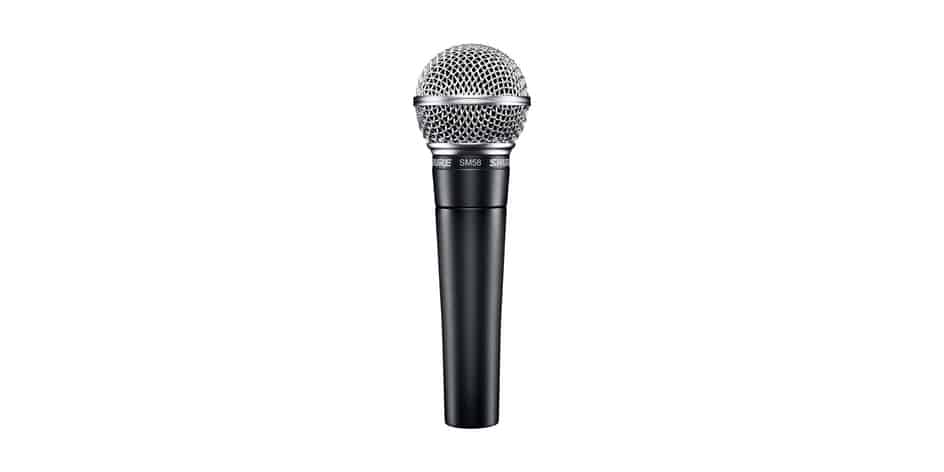
Price: $99.
The Shure SM58 has been the industry standard both for studio recording as well as live performances for decades now.
Even renowned artists like Elton John use them during their live shows… And if it’s good enough for him, it’s definitely good enough for the rest of us.
The reason so many well-known artists use the Shure SM58 so much is because not only is it built like an absolute tank, but it’s also very resistant to feedback and handling noise, making it great for both studio recording as well as live performances.
The Shure SM58 features a cardioid pickup pattern, which means that it will pick up sound from the front, but not from the sides or the rear.
It comes with a mid-boost as well as a bass roll-off which makes it easier for the vocals to cut through the mix without having to apply too much EQ (this is especially useful in live scenarios).
Bonus: This mic doubles as a fantastic instrument recording microphone, be it for drums, guitar cabinets, and more.
Reasons to consider
- Durability: Designed for live shows, making it extremely durable.
- Versatility: Can be used in the studio & live, for vocals, instruments, or any other source.
- Frequency Response: With a mid boost and low cutoff, automatically helps vocals better sit in the mix.
- Price: $99 (and it will last forever).
Find out more about the Shure SM58 here:
- Shure SM58: Amazon, Sweetwater, Guitar Center.
Sennheiser e835
Better for female Vocals than the SM58.
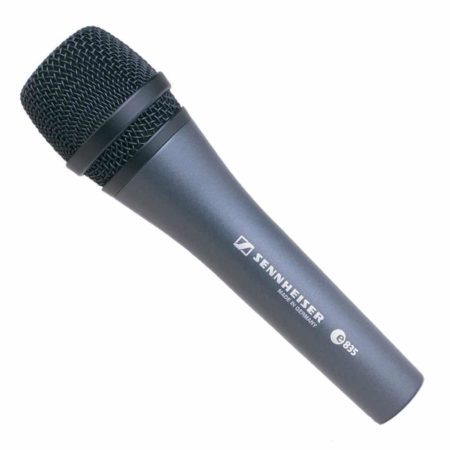
Price: ~$99.
The Sennheiser e835 is a dynamic microphone designed for live shows and studio recording.
This microphone is designed with an advanced internal shock mount to stabilize and protect the capsule from handling noise that can be a problem at higher volumes, and it’s got a uniform frequency pick-up pattern that maintains the signal quality when moving on and off axis during performance.
It has a mid-range and high-end boost, plus a bass roll-off which is great for making vocals sound more natural and warm plus it doesn’t need much EQ’ing them to sit well in a mix, which is why I like it for live performances.
It’s very similar to the SM58 in almost every sense, but the difference lies in how it sounds, and depending on the source, you might prefer one over the other:
My Recommendation between SM58 and Sennheiser e835:
- For male vocals, or any loud source, the SM58 wins (in my subjective opinion).
- For female vocals, on the other hand, I always found the Sennheiser e835 to be better.
Note: If you are looking for an in-depth comparison between the two, check out my article where I compare the Shure SM58 vs the Sennheiser e835.
Reasons to consider
- Durability: Designed for live shows, making it very durable.
- Versatility: Can be used in the studio & live, for vocals, instruments, or any other source.
- Frequency Response: With a mid and high boost and low cutoff, automatically helps vocals better sit in the mix (works best with female vocals).
- Price: $99 (and it will last forever).
Find out more about the Sennheiser e835 here:
- Sennheiser e835: Amazon, Sweetwater, Guitar Center.
Shure SM7B
Best Dynamic Microphone for Vocals
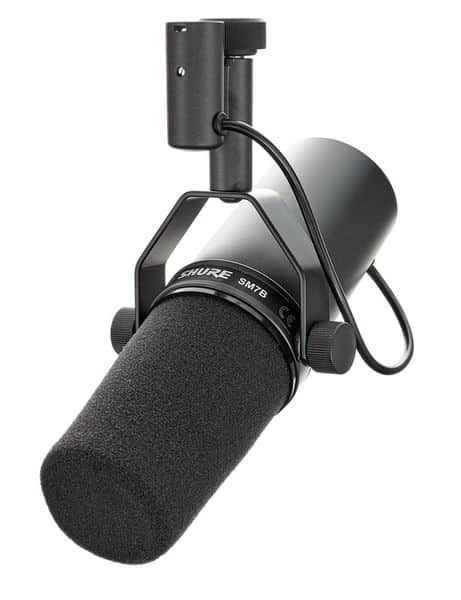
Price: ~$400.
The Shure SM7B cardioid dynamic microphone has been the go-to microphone for podcasting for years now, but not only that, it’s been the go-to microphone for artists like Michael Jackson (he actually used an SM7, which was practically the same mic), to record “Thriller”, “Off the Wall” and “Bad”.
Other artists that also use the SM7B are The Red Hot Chili Peppers, Willie Nelson, Metallica, and many more.
Its most common uses are;
- Radio broadcasting
- Podcasting
- Recording loud and screaming rock vocals
While it may be an excellent microphone (better than the SM58 and the Sennheiser e835), it does have two drawbacks: High price, and a lower than normal output volume.
In order to get a great signal out of the SM7B, not only will you need a high quality audio interface, but you might also need a Cloudlifter CL-1, which essentially pushes the signal to a more “usable” level.
If you are willing to spend close to $500 between the microphone and the added preamp, then the SM7B is a good choice.
Reasons to consider
- Great for podcasting & vocals in general: Best dynamic microphone for singing, and go-to mic for podcasting.
- Versatility: Can be used in the studio & live, for vocals, instruments, or any other source.
Cons
- High price (about $400).
- Requires additional equipment to work properly.
Check prices for the Shure SM7B Here:
- Shure SM7B: Amazon, Sweetwater, Guitar Center.
List of the Best Condenser Microphones for Vocals!
As I mentioned in the beginning, condenser microphones need phantom power to work properly, which means that you may need a standalone audio interface or mixer to be able to record with them.
If you don’t have one, consider either dynamic or USB microphones.
Audio-Technica AT2020
Affordable and very reliable!
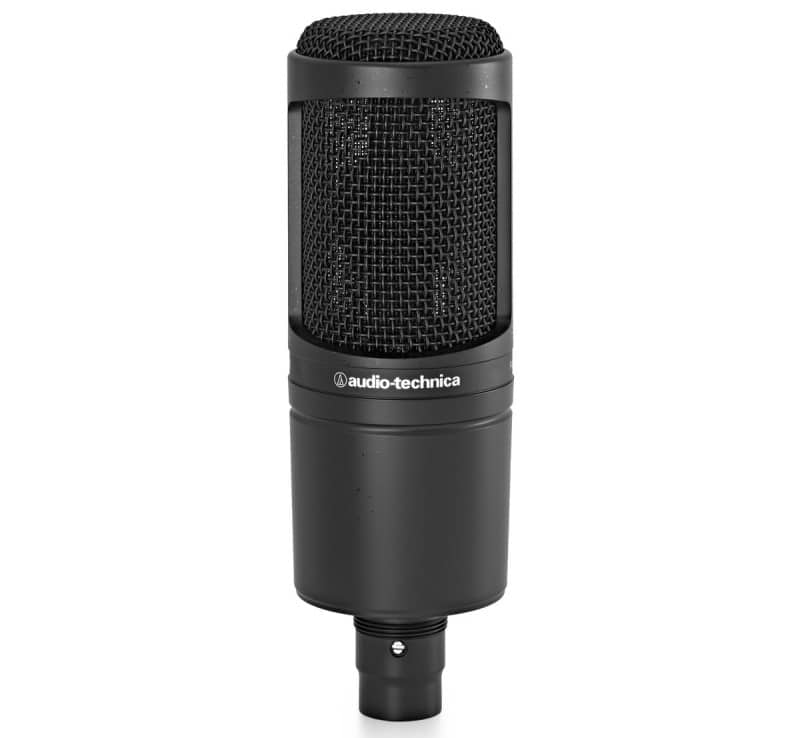
Price: ~$99.
I have used the AT2020 countless times both in studios as well as at home, and it’s an absolute workhorse, which is why you can find at least a couple of them in every professional studio, and this means that they should be more than enough for any beginner who is building their first home recording studio, especially if they’re on a tight budget, or even for any advanced producers who just need a larger number of microphones without breaking the bank.
The AT2020 is a cardioid condenser microphone, it’s build quality is very durable, and it’s probably the best condenser microphone you can get at this price point.
Since it’s a condenser mic, it is mainly designed with studio/home recording in mind, since the small conductive membrane it uses to capture the sound is very light and prone to feedback, making it a poor choice for live scenarios.
Reasons to consider
- Great for studio/home recording: Best budget condenser mic for home studios.
- Voiceover: Can be used to record high-quality YouTube Videos and Voiceovers.
- Podcasting: The cardioid polar pattern makes it great for podcasting.
- Price: $99 (best price for what you get).
Find out more about the Audio-Technica AT2020 here.
- Audio-Technica AT2020: Amazon, Sweetwater, Guitar Center.
Rode NT1
Great Bang-for-buck (includes pop filter, shock mount, & cable)
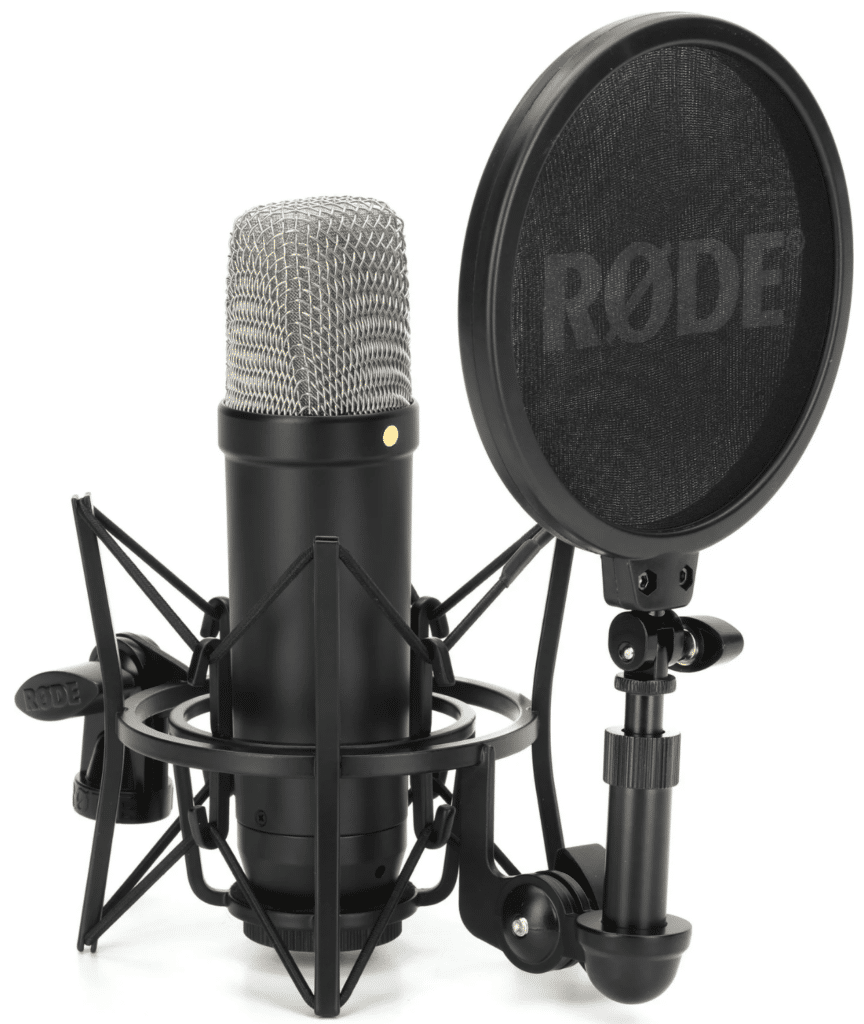
Price: $159.
The Rode NT1 is the one microphone that I’ve been using daily for the past couple of years for vocals since it generally works really well.
One of the reasons that I recommend it so much is that it comes with a High-quality pop filter and shock mount, which means that you automatically save close to $50 since you don’t need to get those extra, and the newer versions of the mic even come with the XLR cable included as well.
Most large diaphragm condenser microphones don’t even provide a regular pop filter, much less one that’s even better than most pop filters out there, and they also don’t include such as great shock mount, which makes this a great first microphone to get.
It has a fairly flat frequency response with some rounded cuts at 20-30Hz and 16k-20kHz, and a small boost in the presence frequencies, and this help your recordings to sit better in the mix without requiring as much EQ.
For anyone who is looking to purchase their first condenser mic, this one may be the best choice since you don’t need to get all of the extras, like pop filter, shock mount, and cable.
Reasons to consider
- Additional Equipment: Includes Pop Filter, shock mount, and cable.
- Great Vocal EQ curve: The frequency response curve is great for vocal recording.
- Voiceover: Can be used to record high-quality YouTube Videos and Voiceovers.
- Podcasting: The cardioid polar pattern makes it great for podcasting.
- Price: ~$159 (best price for what you get).
Find out more about the Rode NT1 here.
- Rode NT1: Amazon, Sweetwater, Guitar Center.
Lewitt LCT 440 PURE
Modern Condenser mic for Vocals
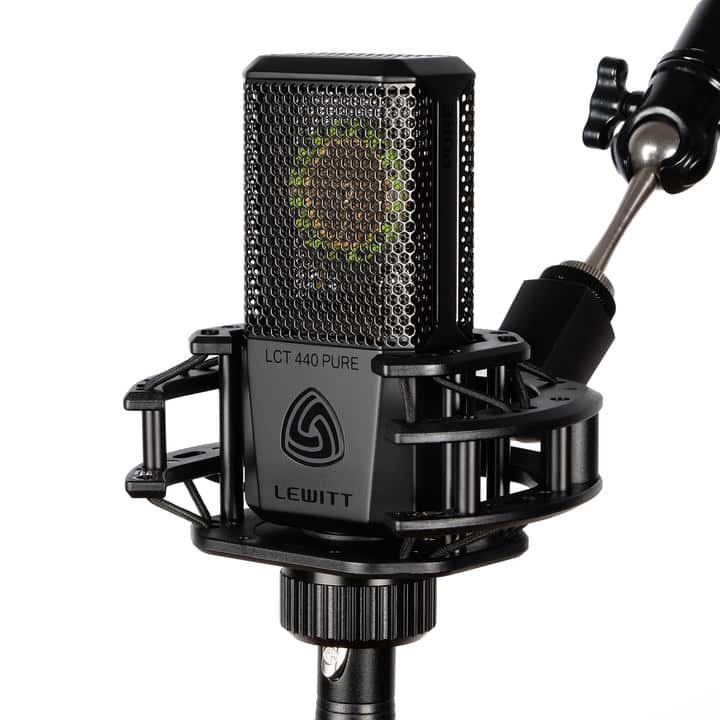
Price: ~$289.
Lewitt has been making waves in the audio industry as of late, coming out with some of the most groundbreaking microphones currently available.
The LCT 440 PURE is probably their best bang-for-the-buck vocal microphone since it has been specifically designed for that purpose (they do offer much higher-end microphones as well, even at $3000+, but this one hits the sweet spot between not too expensive and really high quality).
It is a cardioid large diaphragm condenser microphone that doesn’t feature any sort of high-pass filters, PADs, or anything like that, but it does come included with a pretty good pop filter (I like the one on the Rode NT1 better), a magnetic pop filter (not usual on other microphones), a foam windscreen, and a bag.
Other than that, it features a fairly flat frequency response until the 2k mark. From 2k up to 14k it does have a slight boost of almost 5dB.
Reasons to consider
- Flat Frequency with “Air”: The boost to the higher frequencies adds some airyness to the sound.
- Best For Singing: It’s modern capsule design is excellent for recording singers.
- Voiceover: Can be used to record high-quality YouTube Videos and Voiceovers.
- Podcasting: The cardioid polar pattern makes it great for podcasting.
Cons
- High price (about $289).
- No PAD, HPF, or other similar features.
Find out more about the Lewitt LCT 440 PURE here:
- Lewitt LCT 440 PURE: Amazon, Sweetwater, Guitar Center.
Audio-Technica At4040
High-end microphone for less than $300
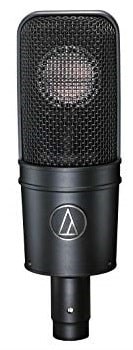
The Audio-Technica AT4040 is considered by many to be the best XLR microphone under $300 currently available.
The build quality is extremely good and comes with two switches on the back which are: A High-pass Filter, that rolls lower frequencies off at about 80Hz at 12dB/octave, and a -10dB PAD in case you are recording a really loud source, making it slightly more versatile than most other condenser microphones.
The built-in high-pass filter (or low-cut filter) is designed to keep the microphone from picking up low-end frequency noises, such as air conditioners, fridges, etc., making it a good choice for home recording artists who are looking for a higher than average quality microphone.
The great thing about the AT4040 is that it’s already a top tier microphone, and if you invest in one, then you won’t ever need to upgrade.
Having said that, the Rode NT1 offers a similar recording quality at half the price, and it comes with the pop filter, the shock mount, and now even the XLR cable.
Reasons to consider
- Flat Frequency Response: Great for capturing the sound source “as is”.
- Voiceover: Can be used to record high-quality YouTube Videos and Voiceovers.
- Podcasting: The cardioid polar pattern makes it great for podcasting.
Cons
- High price (about $300).
- Doesn’t include as much additional gear.
Find out more about the Audio-Technica AT4040 here:
- Audio-Technica AT4040: Amazon, Sweetwater, Guitar Center.
Neumann TLM 102
High-end Vocal Microphone
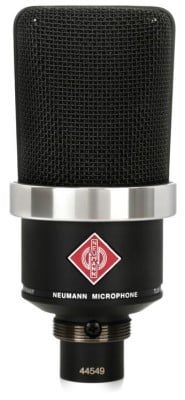
This is by far the best microphone on this entire list… if you have the budget for it, that is.
The construction quality is extraordinary, and it just looks stunning! And if you know anything about Neumann, then you know that they have long been known for making the best microphones, period. Especially if we’re talking about vocal microphones.
Now, it doesn’t come with additional features such as a -10dB or -20dB PAD, High-Pass Filters, or anything else. It’s just the cardioid microphone and that’s about it, but in all honesty, it’s a microphone strictly designed for vocals and to be used in a studio where there is no low-end background noise going on, so these features aren’t really necessary considering its use-case.
Additionally, microphones of this caliber are designed to be used with other equipment of similar quality, which is also a reason to only use it in a professional studio since connecting it to a $100 interface would not allow you to take full advantage of the mic.
Reasons to consider
- Sound Quality: Best Vocal Microphone on this list.
Cons
- High price (about $700).
- Doesn’t include as much additional gear.
- No PAD or HPF.
- Only really usable in studios with other high-end equipment.
Find out more about the Neumann TLM 102 here:
- Neumann TLM 102: Amazon, Sweetwater, Guitar Center.
Best USB Microphones for Vocals
USB microphones come in all shapes and sizes, and after trying dozens of them, I feel like these three should be the only ones to consider.
Audio-Technica AT2020+ USB X
Best Bang-for-your-buck USB mic
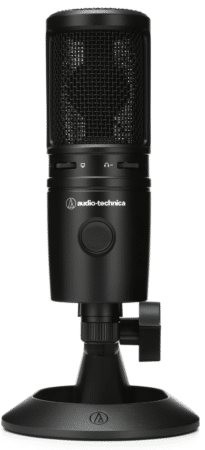
Price: ~$129.
The USB version of the Audio-Technica AT2020 is just as good as the XLR AT2020 with the advantage of being a plug n’ play microphone that works both on Windows and Mac OS without the need of installing any sort of driver, and the newly released “X” version (did Elon name this?), comes with a newly designed look and a mute button.
It also comes with a built-in headphone jack and a volume control that allows you to directly monitor what is being recorded with no delay (Zero latency). It also offers a mix control that blends the microphone and the pre-recorded audio.
The controls on the AT2020 X aren’t as easy to use as I would have liked, such as having the output control not be a typical circular knob, but rather a wheel that you turn.
As far as build quality goes, the AT2020+ is extremely well built: When holding it in my hand it doesn’t feel like a cheap product at all, quite the opposite in fact. I have to give props to Audio-Technica here since I’ve never tried a mic of theirs that doesn’t feel extremely solid).
Lastly, the AT2020+ can be used for anything voice related, recording music, YouTube videos, etc.
Reasons to consider
- Sound Quality: Great for singing and acoustic instruments.
- Durability: Sturdy construction and the USB cable can be swapped out for another one.
Cons
- No Gain dial.
Find out more about the Audio-Technica AT2020+ USB X here:
- Audio-Technica AT2020+ USB X: Amazon, Sweetwater, Guitar Center.
Elgato Wave 3
Best Included Software
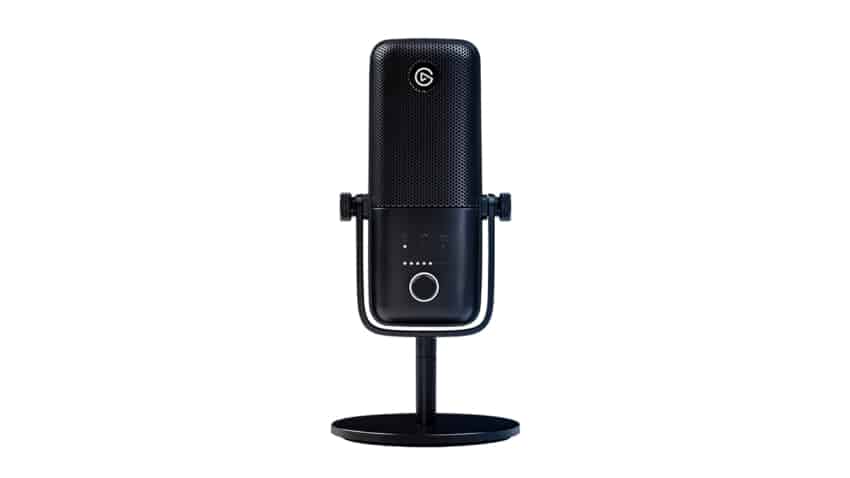
Price: ~$149.
The ElGato Wave 3 was one of the first USB microphones I tested, and even though my expectation weren’t that high, I have to say that it blew them out of the water.
The sound quality is excellent, especially for recording vocals, spoken word, etc., which is what it was designed for since it’s a gaming/streaming microphone.
It features a big gain knob at the font that can also be used to mute the signal, and it offers a headphone jack with zero-latency monitoring.
As far as the build quality goes, it’s nothing to brag about since the body is made out of plastic which does feel a little cheap, and the U-bracket that attaches the mic to the desk-stand is also made of plastic. The mesh grille is metal, but it has a bit of give to it, which isn’t ideal as well.
However, and even despite this, it’s still a great choice for a couple of reasons:
- It features a “Clipguard”, which when enabled will prevent clipping or saturation if you signal gets too loud; like for example if you scream too loudly.
- It also comes with a high-pass filter that can be enabled to remove a bit of the low end, and this can come in handy when you want to better deal with the proximity effect (basically, the closer you get to the mic, the more low-end you will hear, and the high-pass filter helps deal with this).
- The included software can also be used to mix music with the microphone signal should you want to stream.
Despite being marketed as a gaming microphone, the ElGato Wave 3 really does work well for recording vocals. The only con is the build quality.
Reasons to consider
- Sound Quality: Designed to record mainly vocals.
- Included Software: Clipguard, high-pass filters, mixing, etc.
Cons
- Poor build quality compared to the rest.
Find out more about the Elgato Wave 3 here:
- Elgato Wave 3: Amazon.
Rode NT-USB Mini
Great for spoken word & singing

Price: ~$99.
The Rode NT USB Mini is a very small microphone designed to sit on your desk (it can be attached to a boom arm if you want, however).
It features one knob on the front that lets you control the headphone volume and that also allows you to enable zero-latency monitoring when tapping on it. A light on top of the knob will turn on indicating that zero-latency monitoring is enabled (the second light only tells you if the mic is connected and getting power).
It comes with a 360-degree swing mount that is great for setting up the mic on a boom arm since you can turn it however you want until you get it just right.
The NT USB Mini doesn’t come with an included pop filter, but rather has one already built-in, although I have to say that plosives are still kind of an issue and I would recommend using an external pop filter just in case.
To control multiple aspects of the microphone, such as the gain level, headphone mix, and more, you can use the Rode Connect software that comes included.

The Rode Connect software lets you use up to 4 Rode NT USB Minis one a single computer, access some processing which are built into the mic, such as a gate, compression, and more, and it also lets you control the playback volume of different apps and games, which lets you create a nice mix for your stream (great software for gamers).
Lastly, it doesn’t come with a shock mount, and when using it with the included desk stand, it will absolutely pick up all the keyboard strokes, tapping on the desk, or any other types of vibrations that may be present. So, for all you gamers out there, get a boom arm!
Reasons to consider
- Price: At $99, it’s a great choice considering the additional software.
- Fairly good Build quality.
- Sound Quality: Specifically designed for vocal recording.
- Use multiple on the same PC: Connect up to 4 to the same PC and control them with the Rode Connect software.
Cons
- No dedicated gain or mix knobs (everything via software).
- No shock mount.
Find out more about the Rode NT-USB Mini here:
- Rode NT-USB Mini: Amazon, Sweetwater, Guitar Center.
Conclusion
I hope this information was useful.
Depending on your needs you might want a cardioid or condenser mic.
For live shows just go with the Shure SM58, but for recording at home I would either recommend the Audio-Technica AT4040 or the Rode NT1 because of the value they offer.
However, if you have the budget and want a microphone that will never need replacing…
Then the Neumann TLM 102 is your absolute best option.
I hope you have a wonderful day!
